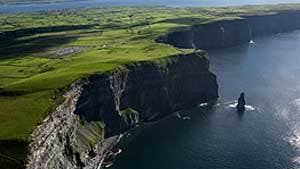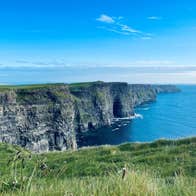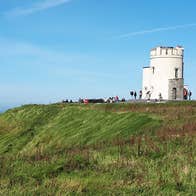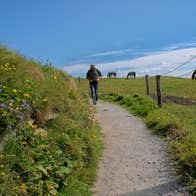The Cliffs of Moher in County Clare have a Special Protection Area for Birds which include the cliffs, the cliff-top maritime grassland and heath, and an area of open water directly in front of the cliffs to protect part of the birds feeding area.
The designation covers 200 hectares and highlights the area’s importance for wildlife. There are more than 20 species of nesting birds within the area, including 9 species of breeding seabirds. Up to 30,000 breeding pairs of seabirds are found annually at the cliffs.
From May to August the gregarious seabirds fill the cliffs with their colour and sound. The cliffs are a birdwatchers dream. They hold one of the five largest concentrations in Ireland for four species of seabirds; Guillemot, Razorbill, Fulmar and Kittiwake, all in nationally important numbers.
The Cliffs of Moher hold the largest mainland colony of Puffins: (1,365 individual adults) in Ireland. The main colony can be seen at Goat Island just under the first viewing point. There are smaller colonies on the grassy summits to the north and south of this area. Razorbill numbers in particular seem to have increased at the cliffs and the site is of international importance for this species. It is recognised by its broader and heavy marked bill.
The Cliffs of Moher is the third-largest site in Ireland for Guillemot: (with a staggering 19,960 individuals). The Guillemot arrives in March/April. One egg is laid directly onto the ledge. The pear shaped eggs and chicks have a precarious existence, but they rarely fall off the nesting ledge. A small number of Black Guillemot also breed here in holes and crevices, especially on the extreme northern and southern slopes of the cliffs. The cliffs contain the second largest colony of Fulmar in Ireland (3,560 apparently occupied sites). They originally came from the Arctic and Iceland and began to colonise Ireland in 1911. Fulmar are present for much of the year, with eggs laid in May. The cliffs are one of the top two sites in Ireland for Kittiwake (approximately 7,700 occupied nests). They are among the first birds to arrive in spring to breed. They are rarely seen near the shore for the remainder of the year, as they spend most of their life in the middle of the south Atlantic.
Small numbers of Herring Gull breed on the stacks or the upper ledges of the cliffs. Great Black-backed Gulls patrol the cliffs for a chance encounter with an unguarded auk egg or chick. Hovering Kestrels float over the cliff tops in search of field mice and large insects. Peregrine breed on the hidden cliff ledges. Shags are also found breeding in small numbers particularly in the caves. Four pairs of Chough breed from Hag's Head to Doolin and are seen feeding on the short grass at the cliff top. Listen out for their harsh 'cheeow' calls. Stonechat and many other common breeding birds are to be seen on the bushes and slate stone walls inland of the cliffs.




